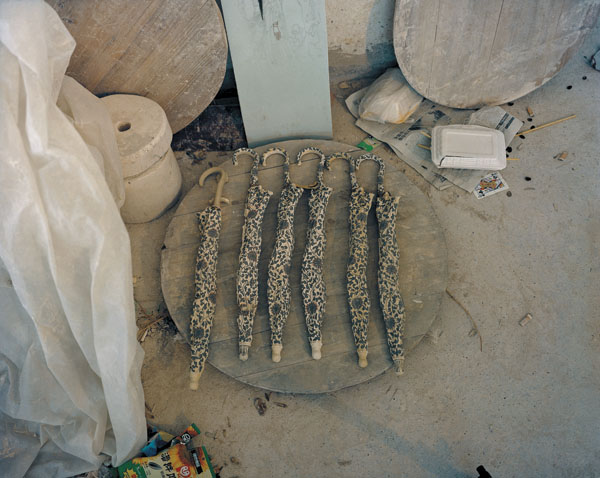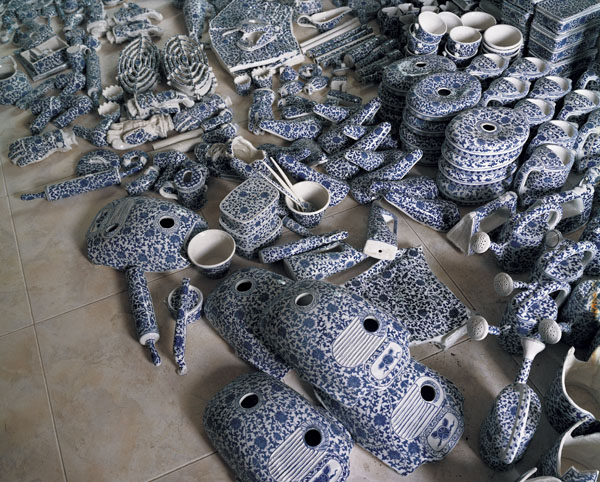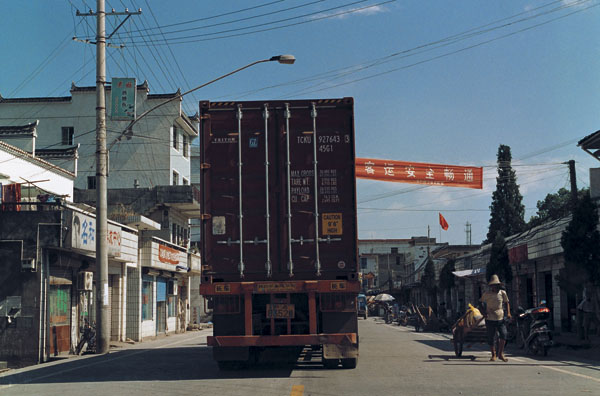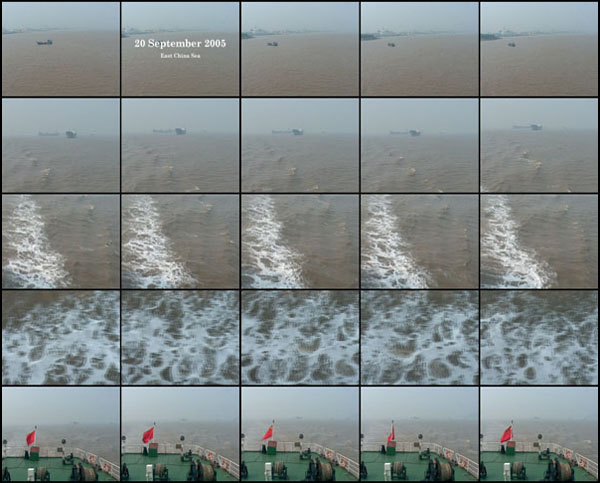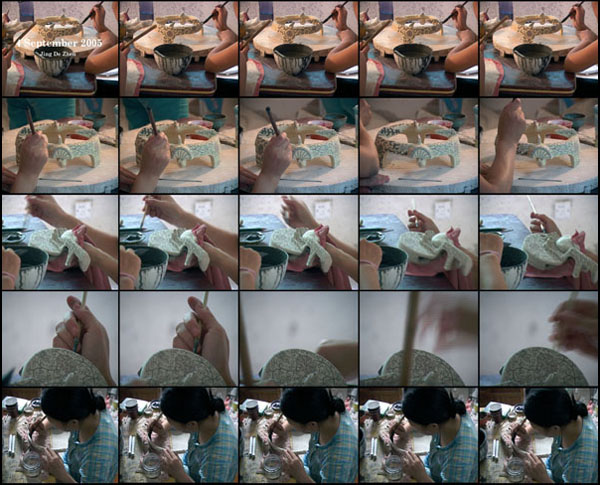
Of the Departure and the Arrival
Beyond the wall
Bert Steevensz
The cargo has arrived in the porcelain factory in Jingdezhen. There is work to be done. Without hesitation the employees open and unpack the various boxes. They are surely curious about the contents. Coming from a far away and prosperous western country the boxes might contain valuable goods. But the sight of the objects sent must have been somewhat disappointing. The majority are old or ordinary objects for daily use. Some of them are even broken. A lid of a vacuum cleaner, a used glove, a tube of toothpaste... But there are also objects or utensils that make sense to the western, or even Dutch eye only, like a typical bean slicer, that until about two decades ago could be found in any Dutch kitchen, but is hardly used anymore, since nowadays the French beans for which it is meant, are mostly bought already sliced.
The objects were gathered from the citizens of the Dutch city Delft for Ni Haifeng’s project Of the Departure and Arrival, an initiative of the municipality of this town. This historical interrelation between China and Holland, especially between the towns of Delft and Jingdezhen is the point of departure for Ni Haifeng’s project. Ni Haifeng invited the citizens of Delft to hand over everyday objects ‘that reflect life and characteristics of the city’. The objects brought in by the citizens vary a lot in character, age and material. The large collection of different objects was sent to Jingdezhen where they were remade in earthenware and decorated with motifs in blue. The porcelain translations of the objects were then transported back to Delft by an international shipping company. This ‘exotic’ cargo was shown at the Prinsenhof museum and on a noticeable boat, docked at a location in Delft with a complex historical significance: a canal between the old VOC house and the weapons museum. Haifeng documented the whole process by video recording and this video documentation forms an important part of the installation in both locations.
With this project Ni Haifeng is reverting to the shared history between Holland and China of the porcelain industry. The town of Delft is synonymous with the Dutch porcelain industry. The refinement of and demand for Chinese porcelain in earlier ages inspired the factories in Delft to imitate the forms and decorations of the imported, expensive chinaware. In the middle of the seventeenth century Delft faience reached a quality unsurpassed in Europe. At the same time the producers of porcelain in China, concentrated in the town of Jingdezhen, kept providing the European market with their porcelain. And they also had to adapt themselves to western taste. So, western decorations were ‘translated’ by the Chinese manufacturers to supply the European market with the westernized ‘chine de commande’. An important role in this trade was played by the VOC or Verenigde Oostindische Compagnie (United East India Company), the first multinational company in history.
In the video documentation the visitor can observe how the private objects form Delft are received and studied by the workers in Jingdezhen. The employees discuss the possibilities and problems of transforming them into earthenware, at least that is what I think that they are doing when they show the objects to one another, pointing at and touching some details. They speak Chinese and there are no subtitles. We see the various molds they made from these foreign objects, we see how they put the wet china clay into the molds, how they are dried and freed again from the molds, how painstakingly but nimbly they are decorating them. We see the firing process, and we also see some rejected products. It is a lively video that makes one wonder how much has changed in the course of centuries, since the factory still looks so basic, as if time hardly had hold over it. But the products leaving this factory are of a stunning quality. They certainly know to transform the most impossible forms into delicate pieces of china.
For me, the most impressive moment is when these objects, each one with its own history and specific meaning, linked with a citizen of Delft, are touched and analyzed by these foreign, Chinese hands and eyes, as a part of the process of identity change they are undergoing. For it is through their hands that the various objects start to take on a much more uniform shape: each of them will be reborn as it were into one and the same material and decorated with identical patterns. They will all get the same look that can be identified as Chinese. So what started as a most private, personal item is being transformed into a more uniform and therefore more abstract object. In this process also the original, emotional value of the objects has also been changed into a more general artistic and economic value. At the same time the objects are now also recognizable as a ‘Ni Haifeng’. It is a play with identity typical for Ni Haifeng’s art. In the Prinsenhof Museum the new objects are subtly placed between the older archeological findings from the city of Delft. The unsuspecting visitor will notice them only if they are struck by the repetition of their decorative patterns.
The afore-mentioned video documentation is shown in the same, open museum room, so the visitor is given the opportunity to understand directly the significance of the strange yet familiar porcelain objects shown. A longer version of the same video is also presented in an intimate rear cabin of an old boat, docked in a canal in Delft with much historical significance. While the video in the Prinsenhof Museum becomes a part of the museum display, as a piece of art itself, the presentation on the boat creates a much more true to life situation and therefore has more physical impact on the viewer. One can almost sense how the objects have crossed the ocean. Perhaps because of the somewhat dingy state of the boat, which in a way matches the situation in the Chinese factory, one can also experience the fabricating process better than within the clean context of the museum. Nearby the rear cabin, in a large cabin of the boat, the most impressive installation of the project is situated. The bulk of the china ware, a thousand or so pieces, are displayed here on the cabin floor, in an orderly way. Notwithstanding their fragility the visitor can even touch and study them. Much more so than in the museum, the individual, personal and tactile aspects of each object are in beautiful balance here with the massiveness and abstraction of the whole presentation. Not all of the goods are unpacked, though. In the same room and on the deck, many boxes are still waiting to be opened, emphasizing the fact that this project is not about the final product, but about the whole fascinating process of identity transformation of the goods, a process that is also visualized in the great amount of photographs hanging and lying in the cockpit of the same boat.
Identity is one of the main themes Ni Haifeng touches upon in his multifaceted work. Cultural identity, personal identity, false identity, ambiguous identity, coded identity, deduced identity, they all are dealt with by the artist in various ways and forms. A stunning series of photographs, Self-Portrait as Part of the Porcelain Export History, shows parts of the artist’s body, painted with decorative patterns for chinaware and with quotes from studies on the trade history of Chinese porcelain. The work displays a clear reference to his Chinese origin and his migration to the West. But it is also so much more. Ni Haifeng presents a clear image raising all sorts of associations. Cultural, economic, human and aesthetic aspects of trade are evoked. Another self-portrait is done on a large museum window. The artist covered the window with black, incomprehensible signs. Is it a secret language, a modern calligraphy? Though some individual signs or symbols are recognizable, for they can be found on our screen, the whole inscription is completely obscure. It seems to be written down with so much passion that some hidden meaning is suggested. There is a ‘meaning’ indeed, but not what we would expect. For it is not a secret text, hiding behind the writing, but an image: a self-portrait of the artist translated into digital, computer codes. The most familiar image, a picture of oneself, disintegrated into an unintelligible combination of scratches. The result is a work as simple as intriguing, for so many questions are evoked. What do we know about ourselves, in the end? Will it ever come so far that we will be able to reproduce ourselves artificially in the future?
With the Delft project Ni Haifeng is again toying with a complex interplay of different aspects. And again the idea of ‘identity’ takes a leading role in this process. The identities of the towns of Delft and Jingdezhen as centers of porcelain production are obvious; a cliche the artist uses deliberately. And the identities of the citizens themselves, symbolized by the personal objects. The translations of the variety of objects into one type of material, decorated with a uniform pattern, give the collection a certain oddity: the objects seem familiar yet are not immediately definable. Only after seeing the video the public will understand what is actually shown. Apart from the historical references, the important role played by the VOC in the past, the exchange of goods through export and import, there is also a fusion of identities. The objects were Dutch in original, but have undergone a process of transformation in China. So are they Dutch or are they Chinese in the end?
Having been born in China and now living in the Netherlands Ni Haifeng continuously faces the otherness of his Chinese background within a West-European society. What does it mean to be a Chinese artist in the West? Questions like these are too frequently put to him. For Ni Haifeng cultural identity is not a static given. Identity is changing in time, a flux. ‘My living here is really an endless process of translation, both in a metaphorical and literal, everyday sense’, Ni Haifeng states in an interview.

